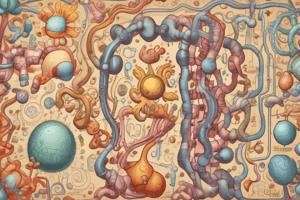Podcast
Questions and Answers
Which statement accurately describes the nature of fatty acids found in the body?
Which statement accurately describes the nature of fatty acids found in the body?
- Odd-numbered fatty acids are primarily synthesized from three-carbon units.
- Free fatty acids are abundant in all tissues under normal conditions.
- Most fatty acids in the body are present as long, straight-chain saturated fatty acids. (correct)
- Fatty acids found in plasma are exclusively short-chain fatty acids.
What is the effect of increasing unsaturation on the melting point of fatty acids?
What is the effect of increasing unsaturation on the melting point of fatty acids?
- Higher levels of unsaturation lead to lower melting points for fatty acids. (correct)
- Unsaturated fatty acids have melting points that are higher than saturated fatty acids.
- Increasing unsaturation raises the melting point of fatty acids.
- The melting points of unsaturated fatty acids remain constant regardless of saturation levels.
In the context of fatty acids, what characterizes the majority of naturally occurring unsaturated fatty acids?
In the context of fatty acids, what characterizes the majority of naturally occurring unsaturated fatty acids?
- Their acyl chains are typically bent due to cis double bonds. (correct)
- They possess trans double bonds which lead to a linear structure.
- Their structure primarily includes branched chains for better solubility.
- They are always found as free fatty acids in high concentrations.
Which statement regarding the solubility of fatty acids is true?
Which statement regarding the solubility of fatty acids is true?
What is a distinguishing characteristic of triacylglycerols containing saturated fatty acids?
What is a distinguishing characteristic of triacylglycerols containing saturated fatty acids?
Which of the following statements about essential fatty acids is correct?
Which of the following statements about essential fatty acids is correct?
What is the primary reason essential fatty acids are crucial for biological functions?
What is the primary reason essential fatty acids are crucial for biological functions?
What differentiates triacylglycerols in naturally occurring fats?
What differentiates triacylglycerols in naturally occurring fats?
How is glycerol activated for the synthesis of triacylglycerols?
How is glycerol activated for the synthesis of triacylglycerols?
What is the primary role of thiokinase (acyl CoA synthetase) in the synthesis of triacylglycerols?
What is the primary role of thiokinase (acyl CoA synthetase) in the synthesis of triacylglycerols?
Flashcards are hidden until you start studying
Study Notes
Lipid Metabolism
- Lipids are insoluble in water, soluble in organic solvents, and related to fatty acids.
- Fatty Acid Properties
- Free or Esterified: Most fatty acids are present in esterified forms, mainly as triacylglycerols (TAGs) in adipose tissue. Free fatty acids (FFAs) are also present, but in lower amounts.
- Short or Long: Fatty acids are mostly long chains, which are hydrophobic and require protein carriers like albumin in the plasma and specialized proteins in the cytoplasm. Short-chain fatty acids can be free.
- Even-numbered or Odd-numbered: Most fatty acids have even numbers of carbon atoms due to their synthesis from two-carbon units (acetyl CoA).
- Straight chain or Branched chain: Most fatty acids are straight chains, but branched-chain fatty acids exist in nature. Phytanic acid, present in dairy products and derived from plants, is an example.
- Saturated or Unsaturated: Saturated fatty acids have no double bonds, while unsaturated fatty acids have one (monounsaturated) or more double bonds (polyunsaturated).
- Melting point: Increases with chain length (longer chains = solid); Decreases with unsaturation (unsaturated = more liquid).
- Cis or Trans isomer: Most naturally occurring unsaturated fatty acids have cis double bonds, resulting in a bent molecule at the double bond.
Nutritional Essential Fatty Acids
- Linoleic and Linolenic acids cannot be synthesized in the body and must be obtained from the diet; They are essential for complete nutrition in humans and many animals.
- Arachidonic acid is not synthesized but can be derived from linoleic acid when it is available.
- Essential Fatty Acid (EFA) importance:
- Components of phospholipids.
- Required for membrane fluidity.
- Required for eicosanoid synthesis.
- EFA deficiency:
- Scaly dermatitis.
- Hair loss.
- Poor wound healing.
- However, deficiency is rare due to the widespread presence of EFAs in food.
Triacylglycerols (TAGs)
- TAGs are esters of glycerol and fatty acids.
- Most TAGs are mixed acylglycerols, with varying fatty acid compositions.
- Storage of triacylglycerols:
- They coalesce within adipocytes to form oily droplets, acting as the major energy reserve.
- Synthesis of triacylglycerols:
- Activation of fatty acids:
- Fatty acids are converted to their activated form (attached to coenzyme A) by thiokinase (acyl CoA synthetase) for TAG synthesis.
- Activation of glycerol:
- Glycerol phosphate is produced through two pathways:
- From glucose via glycerone phosphate (DHAP) in glycolysis.
- From free glycerol by glycerol kinase (present in the liver, but not adipose tissue).
- Glycerol phosphate is produced through two pathways:
- Clinical Correlation:
- Adipocytes require insulin for glucose uptake, meaning limited TAG synthesis during fasting or low insulin levels.
- Reduced TAG production in diabetes mellitus due to inactive or low insulin levels.
- Activation of fatty acids:
- Steps of TAG synthesis:
- Four reactions involving sequential addition of fatty acids, removal of phosphate, and addition of the third fatty acid.
Depot Fat
- Yellow-white droplets of fat in the cytoplasm of adipocytes.
- Sites:
- Under the skin.
- Around organs (e.g., kidney).
- In the omentum and mesentery.
- Composition:
- Mainly TAGs, with small amounts of phospholipids (PLs) and cholesterol.
- Sources:
- Absorbed fat
- Carbohydrates via lipogenesis.
Studying That Suits You
Use AI to generate personalized quizzes and flashcards to suit your learning preferences.




